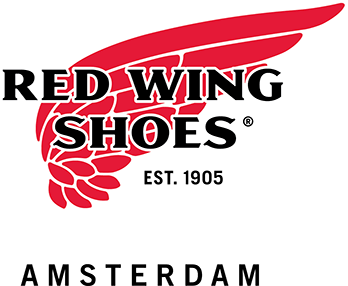Red Wing geschiedenis
In a defining tale of the American Dream, a main street shoe merchant called Charles Beckman spotted a demand for comfortable, durable work boots yet there was no supply. So in 1905, he set up Red Wing Shoe Company, taking its name and logo, by way of a commemorative gesture, from a Native American called Red Wing, the leader of the original inhabitants of the upper Mississippi River territory.
The lasting success of Red Wing is largely due to never compromising their two main criteria for their products, i.e. comfort and quality. This is amply illustrated by the fact that these days, a third generation of employees, located down the road from the original factory, continues the tradition by using the same premium craftsmanship and attention to detail: triple-stitched seams, sturdy welt construction and rich leathers are signature elements of a Red Wing boot. The original factory, we might add, is to this day being used by Red Wing for new product development.
For over a century, this commitment to excellence has been handed down to these generations of shoemakers, and it is all this that won the Red Wing Shoes corporation a place in our hearts.
Charles Beckman
Charles Beckman, a successful Main Street shoe merchant creates the Red Wing Shoe Company with 14 other local business investors. Their goal; build a better work boot.
Original Work Boot
The original work boot from the first year of Red Wing production combined leather, buckles and laces for a secure fit.
Plant 1
The original Red Wing Shoe plant located at the corner of Main Street and Potter. Today the location is used by the company for new product development.
Cutting Room
The first generation of shoe making craftsmen cut Red Wing’s heavy weight, high quality leather by hand.
Red Wing City
View of Main Street in 1900 from Barn Bluff.
Fitting Room
The signature triple-stitch sewing pattern is used to sew the pieces together.
Horse Drawn Wagon
Finished shoes, packed in wooden crates, are loaded on wagons headed to the nearby Mississippi riverfront for loading onto trains and riverboats destined for retailers throughout the upper Mississippi valley.
Army Shoe
To support the war effort, Red Wing redirects its boot production to support America’s doughboys serving their country in World War I.
Quality Ad.
Outstanding quality was the essence of Red Wing products. This 1919 ad highlights the quality of hand-nailed Red Wing boots.
Oil King boots
With the introduction of boots for oil field workers, Red Wing begins developing specialty work boots to meet specific occupational needs.
Brown Chief
Introduced in 1919 as a farmer’s boot. The boot used special leathers, tanned to withstand harsh farming conditions. This boot expands Red Wing’s reputation of quality across more of America.
Red Wing Logo
The Red Wing winged logo from 1928 is introduced. The logo is modeled after the feathers used in Chief Red Wing’s ceremonial headdress.
J.R. Sweasy
J.R. Sweasy becomes president of Red Wing Shoe Company. He would be the first of three generations of the Sweasy family to lead the company.
Billy Boot
Built to meet the demands of America’s adventurous youths, the style featured a side snap pocket for a pocket knife. It would be one of the company’s top selling styles.
Steel Toe
Red Wing introduces its first steel toe work boot.
Mobile Shoe Sales
Red Wing introduces its first mobile shoe sales service. Now the shoe store can be brought to the factory location for workers to buy shoes.
Engineer Boots
In the 1930’s trains were America’s transportation backbone. The Engineer boot was created to serve the needs of the men who piloted these steam puffing behemoths.
Irish Setter
The model 877 hunting boot is introduced. The unique red color of the leather mirrors the distinctive coat of a classic upland bird dog; the Irish Setter. This match lead to the boot’s unique ‘Irish Setter’ name and dog logo.
Plant 2
A second plant is opened in Red Wing, MN to keep up with the growing worldwide demand. It is located 3 miles down the road from the original Plant 1 facility.
Rockwell Ad.
The renowned illustrator Norman Rockwell, recognized for his unique style of capturing life of main street America is hired to create advertising images for the company.
Pecos Boots
In 1953 Pecos boots were the first to combine durability, comfort and western styling. They would soon be worn on oil rigs, farms and job sites around the world.
Super Sole
Direct attach construction using a urethane sole was introduced. Named Super Sole, the new process delivered on its promise of superior durability and comfort
S.B. Foot Tanning
Opened in 1887, the Red Wing, Minnesota based business, S. B. Foot Tanning has been supplying Red Wing with premium leathers since 1905.
Cutting Room
Today the cutting room operates much as it did in 1905. Skilled craftsmen still hand-cut the leather to yield premium parts for Red Wing’s high quality footwear.
Fitting Room
Skilled sewers piece together the hand-cut leather parts. Original machines from 1905 are still used, along with our signature triple-stitched sewing pattern.
Red Wing Logo Updated
True to its original shape and color the Red Wing Shoes mark is updated for the times, but remains true to its heritage.
Cork Filling
Cork filling is applied to the insole. The durable cork material will mold to the individual’s foot shape providing all day comfort and long lasting durability.
Beckman 9010
A dress leather boot with work boot styling, the Beckman boot uses premium Featherstone leather to create a dress boot that is still true to its work boot roots.
Red Wing in Amsterdam
Opening of the Red Wing Shoe Store Amsterdam.
